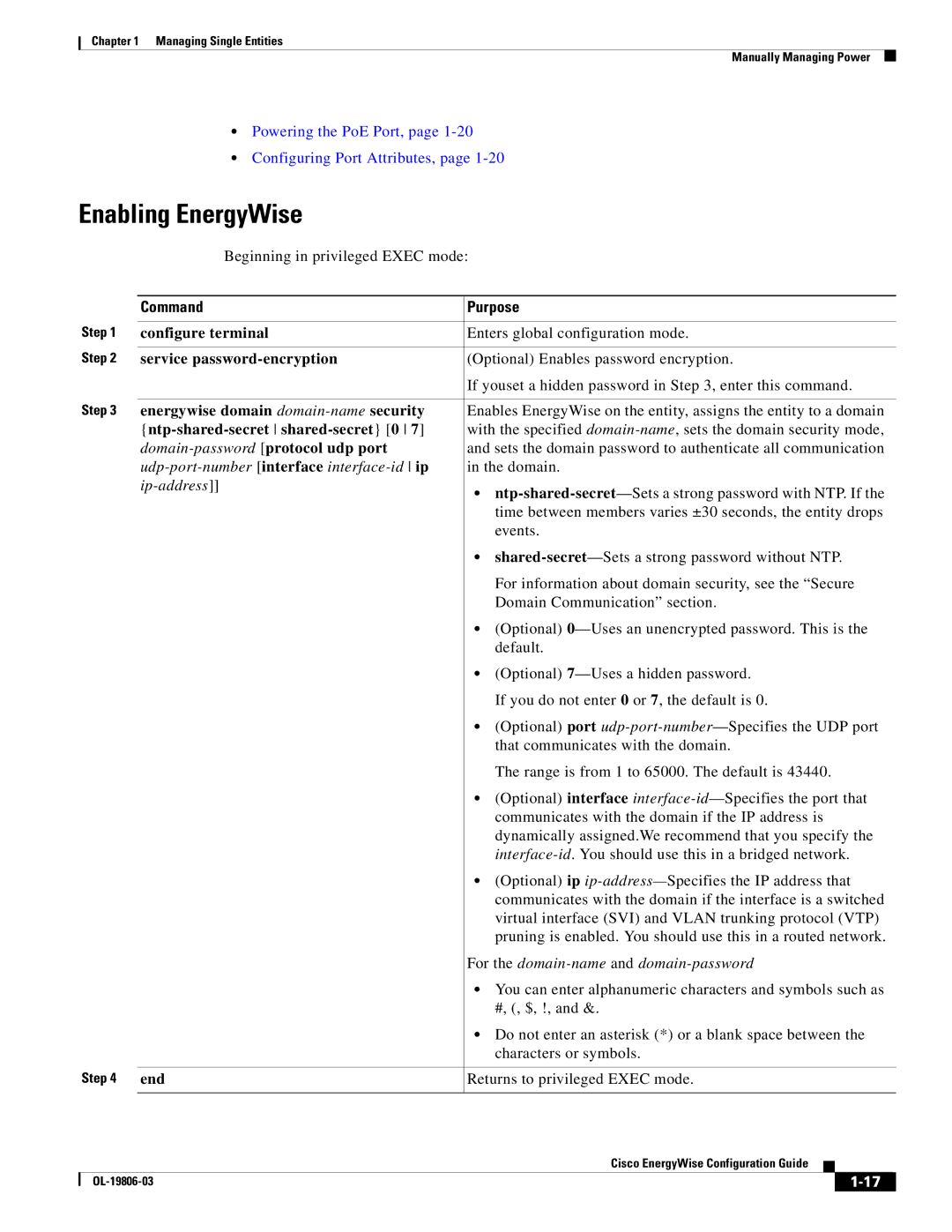Americas Headquarters
Cisco EnergyWise Configuration Guide
Cisco EnergyWise Configuration Guide
N T E N T S
Important Notice C-1
Purpose
Audience
Conventions
Preface
For information about the Cisco network devices, see
Related Publications
Obtaining Documentation, Support, and Security Guidelines
Managing Single Entities
Overview
Domain members
Network management stations
Creating an EnergyWise Domain
Category Level Description
Power Levels
Attributes
Definition Defaults
Recurring Event
Secure Domain Communication
MIBs
Management station Domain member
Switch Connected to an IP Phone
Switch and PC Scenario
Switch Connected to a PC
Configuration Guidelines
Cisco EnergyWise Configuration Guide
This is the configuration for the PoE port
Using the Call In-Progress Feature
PoE and EnergyWise Interactions
EnergyWise Entity PoE Mode Auto Never Static
Preventing Network Access to a Non-Cisco End Point
PC without Access to the EnergyWise Network and the Internet
CLI Compatibility Issues
Enabling EnergyWise, Configuring Entity Attributes,
Manually Managing Power
Command Purpose
Energywise importance importance
Shared-secret 0 7 mgmt-password port
Energywise keywords word,word
Energywise management security
Energywise neighbor hostname ip-address
Energywise name name
Energywise role role
Energywise allow query save set
Interface interface-id
Copy running-config startup-config
Energywise level level
Show energywise children
Energywise role role
Energywise name name
Show running-config
Configuring Recurring Events
Energywise activitycheck
Energywise allow query set
Monday , Tuesday , Wednesday , Thursday , Friday
Energywise level level recurrence importance
Copy running-config startup-config
Show energywise recurrence
Dayofmonth month Dayofweek timerange
Command Mode Purpose
Disabling EnergyWise
Examples
To power on the lab IP phones
To power off anIP phone connected to a PoE port
Automatically Managing Power
Pc-mgr
If the time range has end times and days such as
Running Queries
Managing Multiple Entities
Managing Multiple Entities Running Queries
Management station End point Domain member
Multiple Switches Connected to Multiple End Points
Delta usage timeout timeout
Using Queries to Manage Power in the Domain
Energywise query importance importance
Keywords word,word, ... name name collect
Keywords word,word, ... name name set level
Optional Runs a query to power on or off the domain members
Querying with the Name Attribute
Verify the power levels
Setting the Time-Out Value
OL-19806-03
EnergyWise CLI Commands
Clear energywise neighbors
Debug energywise endpoint management
Debug energywise
Endpoint
Management
Domain member, configures the switch to
Energywise global configuration
Save-Responds to a query to save the running configuration
Energywise allow query save set
Name name
Level level
Neighbor hostname
Role role
Keywords
Neighbors are not assigned Role is the model number
Allow query save set keywords were added
Management passwords
No energywise domain
Energywise interface configuration
Activitycheck
Allow query set
Recurrence
Keywords word,word
Importance importance
Time-range
Security
Command Default Command Modes Command History
Udp port
Absolute
Command Description
Security
Energywise domain
Ntp-shared-secret
Protocol udp port
Related Commands Description
Command Modes Command History
Usage Guidelines Examples
Energywise query
Timeout timeout
Collect delta usage
Sum delta usage
Set level level
Members and end points
Delta-Display the delta vector
Switch# energywise query importance 90 name * collect delta
Switch# energywise query importance 90 name * set level
These examples show how to filter results with keywords
Event-occured
Snmp-server enable traps energywise
Level-change
Neighbor-added
To send only EnergyWise event traps to the NMS
To send EnergyWise traps to the NMS
Show energywise
Switch# show energywise children
Domain Cisco Protocol
Statistics
Enables and configures EnergyWise on the entity
Energywise global configuration
Energywise interface configuration
Configures EnergyWise on the PoE port
OL-19806-03
Using CLI Commands
Verifying the Power Usage
Cisco EnergyWise and Catalyst 4500 Switches
OL-19806-03
Cisco EnergyWise and Catalyst 6500 Switches
OL-19806-03
Disclaimer
Important Notice
Cisco EnergyWise Configuration Guide
Bewaar Deze Instructies
Statement 1071-Warning Definition
Avvertenza Importanti Istruzioni Sulla Sicurezza
Warnung Wichtige Sicherheitshinweise
Guarde Estas Instruções
Aviso Instruções Importantes DE Segurança
GEM Disse Anvisninger
Page
OL-19806-03
